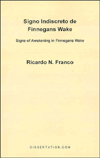

 |

|

Sold Out
Book Categories |
This study starts from the recognition that there is no separation among the words of Finnegans Wake and, furthermore, no linguistic discreteness in a broad definition of language. Traditional ideas of "cohesion," the phenomenological emphasis on the experience of reading, Umberto Eco's "openness," Derrida's "dissemination," or Wakean critics' interest in puns, have all pointed to this aspect of language. Briefly stated, when meaning stops framing phonic configurations, the result is that words touch one another, for they share this material foundation. Phonemes continue to represent sounds, but do not separate words into distinct units; rather they show the analogies among them.The difference between "mass" and "mess," for example, says a lot about the distinctive capacity of phonemes and the alphabet, but very little about the many similarities in these two words. It follows that there is something not exactly alphabetical in language that is prompted by similarities like these. Even quotidian reading exhibits non-alphabetic ingredients, for instance when we skip spelling mistakes or typographical errors; i.e.: when we impose analogies over differences, hermeneutics over semiology, semasiography over the alphabet. Joyce, who once commented that "a few letters will do if you can't read a whole word," just incorporates another system of writing to his "cyclical history," very much in keeping with Vico's idea that each cycle has its own writing system. The incorporation of this non-alphabetic, semasiographic way of reading also explains the presence of allusions and opens up the apparent conflict between allusion and intentionality. How far can analogies go? or rather, can allusions and intentionality be reconciled? They both reveal the existence of coincidences (facilitated by the narrow range of the alphabet); some of them Joyce surely saw, many others produced by mere chance. Chance, then, is the realm that, far from making them opposite, reunite intentionality and allusion, for both depend on the previous existence of coincidences. In Finnegans Wake the search for coincidences marks the beginning of awakening. Using Joyce's additions to his drafts as orientation, particularly those that refer to the Egyptian Book of the Dead, it is possible to trace the resurrection process that Shaun undergoes. Shaun finds the keys to conventional language and to his awakening, like in the fairy tale, in an intentional act of love, in a kiss.
Login|Complaints|Blog|Games|Digital Media|Souls|Obituary|Contact Us|FAQ
CAN'T FIND WHAT YOU'RE LOOKING FOR? CLICK HERE!!! X
 You must be logged in to add to WishlistX
 This item is in your Wish ListX
 This item is in your CollectionEl Signo Indiscreto de Finnegans Wake
X
 This Item is in Your InventoryEl Signo Indiscreto de Finnegans Wake
X
 You must be logged in to review the productsX
 X
 X

Add El Signo Indiscreto de Finnegans Wake, This study starts from the recognition that there is no separation among the words of Finnegans Wake and, furthermore, no linguistic discreteness in a broad definition of language. Traditional ideas of cohesion, the phenomenological emphasis on the expe, El Signo Indiscreto de Finnegans Wake to the inventory that you are selling on WonderClubX
 X

Add El Signo Indiscreto de Finnegans Wake, This study starts from the recognition that there is no separation among the words of Finnegans Wake and, furthermore, no linguistic discreteness in a broad definition of language. Traditional ideas of cohesion, the phenomenological emphasis on the expe, El Signo Indiscreto de Finnegans Wake to your collection on WonderClub |